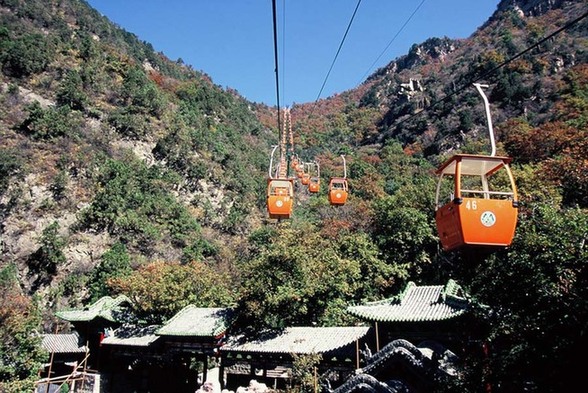Lord Jie Ridge Scenic Spot at Mianshan Mountain
 0 Comment(s)
0 Comment(s) Print
Print E-mail China.org.cn, April 15, 2016
E-mail China.org.cn, April 15, 2016
|
|
|
[Photo/China.org.cn] |
Lord Jie Ridge is the place where Jie Zitui lived in seclusion and was later burned to death. The main attractions in the scenic area are Yuanhao Slope, the Mianshan Stele Forest, the Immortal Stone Forest, the Hujie Stone, Mother and Son Stone, Lotus-Leaf Spring, White Crow Mountain, Turtle Mountain, Fire-Preventing Cave, Lord Jie Ridge, Cypress Ridge and Lord Jie’s Tomb.
Surrounded by mountains, Lord Jie Ridge has a gorge in front, rivers in back, springs on the left and valleys on the right. It is covered with green pine trees and mountain wildflowers. Here you can view a vast sea of clouds and mist, as well as splendid temples below. It is not unheard of for rain to be pouring at the foot of the mountain while the mountainside is bathed in sunshine, and beautiful clouds and mists often wreathe the mountain peak.
Lord Jie Shrine, located in Lord Jie Ridge Scenic Area, is the largest grotto temple in China. Built into a huge hillside cave, it is 22 meters high, 40 meters wide and 25 meters deep and is supported by two towering ellipsoid columns. Inside the temple is an 11-meter-high statue of Jie Zitui, flanked by statues of his mother and Xie Zhang. Dozens of relief sculptures on the cave walls and columns vividly tell the story of Jie Zitui's life.
Baishu (Cypress) Ridge is approximately five kilometers in circumference. It is home to the Qin Cypress, known as China’s king of cypresses; the Mother and Son Cypress, which symbolizes Jie and his mother; the Dragon-Shaped Cypress, the roots of which cling to the side of the cliff; and numerous cypresses resembling tigers, phoenixes, elephants and deer. Cypress Ridge also lies at the intersection of a valley, a rocky gorge and a mountaintop from which one can see Mianshan Mountain and enjoy panoramic views.
The Tomb of Lord Jie is located in the middle of Cypress Ridge at the top of a path composed of 2,000 stone steps. It was built to house the remains of Jie Zitui that were recovered by the entourage sent by the King of Jin. Tombs from the Yuan, Ming and Qing dynasties have also been found in the vicinity of Jie Zitui’s tomb.
The Stele Forest of Mianshan has a collection of exquisite calligraphy works by 100 people, including the Tang dynasty’s Emperor Taizong Li Shimin, Generals Wei Zheng and Zhang Liang, and scholars He Zhizhang and Guo Tai. There are several peculiarly shaped steles here, some of which are square, hexagonal or octagonal. The inscriptions on these steles praise the mythology of Mianshan Mountain and Jie Zitui's unshakable integrity. The calligraphy on these steles is wrought in a variety of styles, including big and small seal script, official script (an ancient calligraphy style from the Han dynasty), regular script, cursive handwriting and grass script.







Go to Forum >>0 Comment(s)